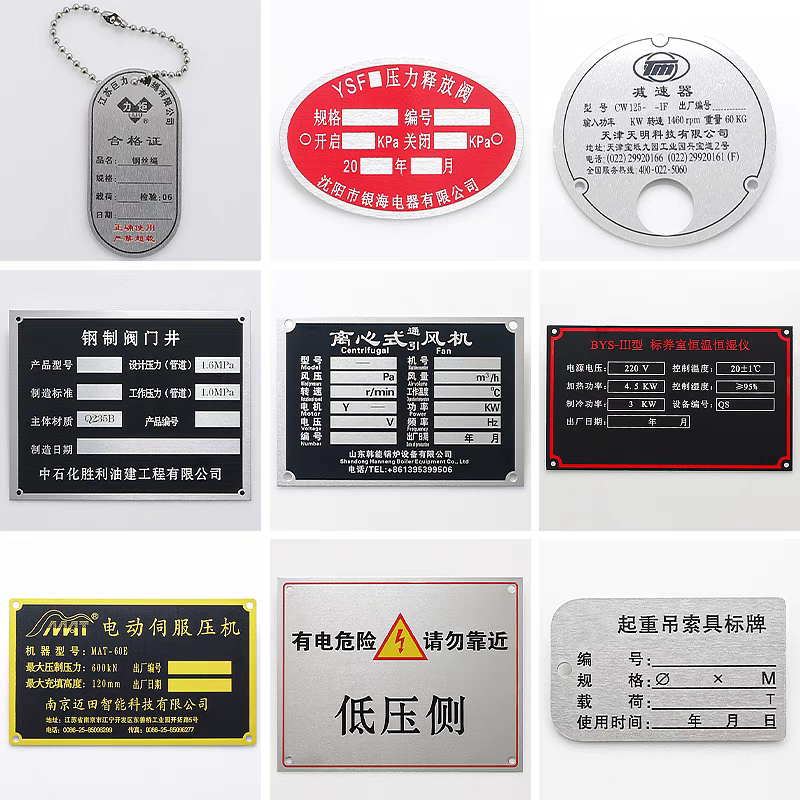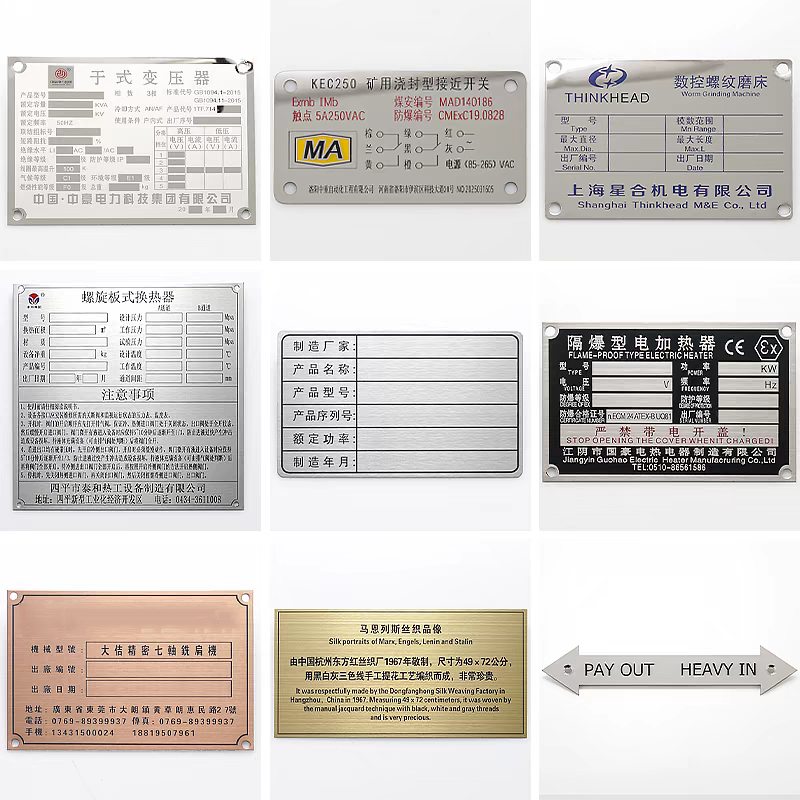Fuel tanks are ubiquitous, storing the vital energy that powers our world – from vehicles and generators to industrial facilities and aircraft. Yet, amidst the complex machinery, a seemingly simple component plays a disproportionately vital role in safety, compliance, and operational efficiency: fuel tank identification tags. These unassuming markers are far more than just labels; they are essential communication tools packed with critical information. Understanding their importance and proper implementation is non-negotiable. Here are 7 crucial aspects you need to know:

1. What Exactly Are Fuel Tank Identification Tags & Why Are They Non-Negotiable?
Fuel tank identification tags are durable, permanently affixed markers designed to convey essential information about the tank they are attached to. They are not mere stickers or temporary labels but engineered solutions meant to withstand harsh environments. Their primary purpose is unambiguous identification and communication.
The critical need for these tags stems from several fundamental requirements:
Safety First: In an emergency – a fire, leak, or accident – emergency responders must know instantly what type of fuel is inside the tank (gasoline, diesel, jet fuel, propane, hazardous chemicals) to take appropriate action. Misidentification can lead to catastrophic consequences, including using the wrong firefighting agent or underestimating the risk. Fuel tank identification tags are the first line of communication in such scenarios.
Regulatory Compliance: Numerous national and international regulations (like OSHA, NFPA, DOT, ICAO, IMO) mandate clear, permanent identification of fuel storage containers. Failure to display compliant fuel tank identification tags can result in significant fines, operational shutdowns, and legal liability.
Operational Efficiency: Clear identification prevents dangerous errors during refueling or maintenance. Workers need to confirm they are adding the correct fuel type to the right tank or servicing the appropriate unit. Fuel tank identification tags eliminate guesswork and potential cross-contamination.
Asset Management: Tags often include serial numbers, capacity ratings, manufacturer details, and construction dates. This information is crucial for inventory management, maintenance scheduling, warranty tracking, and lifecycle planning of the tank assets.
2. Navigating the Regulatory Maze: Compliance Requirements for Fuel Tank Tags
Compliance isn't optional; it's a legal and ethical imperative. Fuel tank identification tags must meet specific standards depending on the tank's application, location, and contents. Key regulatory frameworks include:
OSHA (Occupational Safety and Health Administration): OSHA's Hazard Communication Standard (HCS), particularly relevant for workplaces, requires containers of hazardous chemicals (including many fuels) to be labeled with identity and appropriate hazard warnings. Permanent fuel tank identification tags fulfill this requirement for stationary and mobile tanks.
NFPA (National Fire Protection Association): NFPA 30 (Flammable and Combustible Liquids Code) and NFPA 58 (Liquefied Petroleum Gas Code) have stringent requirements for marking tanks with contents, capacity, and hazard warnings. These standards heavily influence fire code enforcement globally.
DOT (Department of Transportation): For tanks involved in transportation (e.g., on trucks, trailers, railcars, or portable tanks shipped), DOT regulations (49 CFR) dictate specific fuel tank identification tags or placarding requirements, including hazard class diamonds, identification numbers (like UN1203 for gasoline), and proper shipping names. Durability standards for these tags are exceptionally high.
ICAO/IATA (International Civil Aviation Organization/International Air Transport Association): Aircraft fuel tanks and ground fuel handling equipment require specific markings compliant with international air transport safety regulations.
IMO (International Maritime Organization): Marine vessels and offshore fuel storage mandate compliant identification per SOLAS (Safety of Life at Sea) and MARPOL regulations.
EPA (Environmental Protection Agency): Underground Storage Tanks (USTs) have specific registration and marking requirements, often integrated into the tank's permanent identification tags.
Compliant fuel tank identification tags are not generic; they must display the precise information required by the governing regulations for that specific application.
3. Built to Last: Materials & Durability of Fuel Tank Identification Tags
Given the environments they operate in, fuel tank identification tags must be extraordinarily resilient. Cheap labels fade, peel, corrode, or become illegible, rendering them useless and non-compliant. High-quality tags utilize robust materials:
Metallic Tags:
Anodized Aluminum: Highly resistant to corrosion, chemicals (including fuels and cleaning agents), UV radiation, and abrasion. Lightweight yet very durable. Ideal for most above-ground applications (vehicles, generators, industrial tanks). Allows for permanent etching or high-quality printing.
Stainless Steel: Offers superior strength and extreme resistance to corrosion, high temperatures, and physical impact. Essential for harsh environments like marine applications, chemical processing plants, or areas with severe weather or exposure to aggressive substances. Often used with embossing or etching.
Brass/Bronze: Used less commonly now but offer good corrosion resistance; sometimes seen in specific historical or marine contexts.
High-Performance Plastics: Engineered thermoplastics (like UV-stabilized Polyester or Polycarbonate) can be suitable for less extreme environments where chemical resistance and moderate durability are sufficient. Often used for smaller tanks or specific indoor applications. Must be chosen carefully to ensure fuel and solvent resistance. Generally less durable than metal tags long-term.
Surface Treatments & Marking Methods:
Chemical Etching: Removes material to create permanent, deeply engraved markings that won't fade or rub off. Excellent for barcodes, serial numbers, and critical text. Common on aluminum and stainless steel fuel tank identification tags.
Embossing: Raises characters/designs above the tag surface. Very durable but offers less fine detail than etching. Common on stainless steel.
High-Temperature/UV-Resistant Printing: Special inks and processes (like thermal transfer or laser marking) are used to print information onto tag surfaces. Must be specifically formulated to resist fuel, oil, solvents, sunlight, and abrasion. Often used in conjunction with protective overlaminates.
The choice of material and marking method depends entirely on the specific operating environment, required lifespan, regulatory demands, and the nature of the information to be displayed on the fuel tank identification tags.
4. Decoding the Information: What Must Appear on Fuel Tank Identification Tags?
The specific data required on a fuel tank identification tag is dictated by regulation and application. However, common critical elements include:
Fuel Type/CONTENTS: The most crucial information. Clearly state the specific fuel or chemical stored (e.g., "DIESEL FUEL," "UNLEADED GASOLINE," "JET A-1," "LIQUEFIED PETROLEUM GAS," "HYDRAULIC OIL"). Use standard industry names.
Hazard Warnings/Symbols: Mandatory for hazardous materials. This includes:
Hazard Pictograms: Globally Harmonized System (GHS) symbols (e.g., flame for flammables, skull and crossbones for toxicity).
Signal Words: "DANGER" or "WARNING".
Hazard Statements: Standardized phrases describing the nature and severity of the hazard (e.g., "Highly flammable liquid and vapor," "May be fatal if swallowed and enters airways").
Precautionary Statements: Measures to minimize/prevent adverse effects (e.g., "Keep away from heat/sparks/open flames," "Wear protective gloves").
Tank Capacity: The maximum volume the tank is designed to hold (e.g., "CAPACITY: 500 GALLONS," "2000 LITERS").
Working Pressure (for pressurized tanks): Essential for LPG, CNG, and other compressed gas fuel tanks (e.g., "WORKING PRESSURE: 250 PSI").
Manufacturer Information: Name or logo of the tank manufacturer.
Serial Number/Unique Identifier: A unique number assigned to the specific tank for traceability, maintenance records, and registration.
Manufacture Date/Compliance Date: Date the tank was built or certified.
Model Number: Manufacturer's model designation.
Regulatory Compliance Marks: Symbols or text indicating compliance with specific standards (e.g., DOT specification, ASME boiler code stamp, UL listing mark, "NFPA 30 Compliant").
Barcodes/QR Codes: Increasingly common for linking to digital records, maintenance history, or safety data sheets (SDS).
Emergency Contact Information: Sometimes required or recommended (e.g., 24-hour spill response number).
The fuel tank identification tag must present this information clearly, legibly, and permanently.

5. Installation Best Practices: Ensuring Your Fuel Tank Tags Are Effective
Even the best fuel tank identification tag fails if it's not installed correctly. Key best practices include:
Location, Location, Location: Tags must be readily visible and accessible for inspection, especially in an emergency. Common placements include:
Near fill points.
Adjacent to gauges or valves.
On the side of the tank facing primary access points.
Avoid locations prone to damage from impact, abrasion (e.g., from hoses or boots), or being obscured by dirt, paint, or other equipment.
Permanent Attachment: Tags must be affixed securely and permanently to withstand vibration, weather, and accidental contact. Methods include:
Welding: Directly welding stainless steel tags or welding mounting studs/pads to the tank.
Riveting: Using corrosion-resistant rivets (stainless steel or monel) through holes in the tag and tank.
Industrial Adhesives: High-strength, fuel-resistant epoxies or VHB tapes designed for metal bonding. Surface preparation is critical for adhesion longevity.
Stainless Steel Straps/Bands: Securing the tag with a durable band around the tank or a pipe.
Surface Preparation: Clean the mounting surface thoroughly. Remove all dirt, grease, oil, rust, and loose paint. For adhesive mounting, follow the adhesive manufacturer's prep instructions precisely (often involving specific cleaners and primers).
Protection from Elements: Ensure the mounting method and tag location minimize exposure to direct high-velocity spray (e.g., pressure washing), extreme physical abrasion, or corrosive chemical pooling. Tags should not be mounted where they will be submerged in liquid.
Regular Inspection: Include fuel tank identification tags in routine safety and maintenance inspections. Check for:
Legibility (fading, scratching, corrosion obscuring text).
Secure attachment (loose rivets, peeling adhesive, broken welds).
Damage (bending, cracking).
Currency (ensure information, especially hazard warnings, reflects current contents if tanks are repurposed – which often requires replacing the tag!).
Proper installation ensures the fuel tank identification tags perform their critical safety function throughout the tank's operational life.
6. Beyond Basic Identification: Specialized Fuel Tank Tag Applications
While the core principles apply, fuel tank identification tags take on specific forms and requirements in different sectors:
Aviation (Aircraft & Ground Support): Tags on aircraft fuel cells and ground refuelers are critical for safety. They must withstand extreme temperatures, vibration, jet fuel, and de-icing fluids. Compliance with FAA, EASA, and ICAO standards is mandatory. Information includes specific fuel grade (Jet A, Avgas 100LL), capacity, and often pressure ratings. Durability standards are exceptionally high.
Marine (Vessels & Docks): Fuel tank identification tags face constant saltwater exposure, requiring premium corrosion resistance (typically Type 316 stainless steel). Compliance with USCG, IMO, and classification society rules (like ABS, Lloyd's Register) is essential. Tags often include specific marine hazard warnings.
Transportation (Trucks, Trailers, Rail): Tags on vehicle-mounted fuel tanks (e.g., for auxiliary power, refrigeration units, or fuel delivery trucks) must meet stringent DOT durability requirements for vibration, impact, and weather. Hazardous materials placarding regulations often apply.
Industrial & Manufacturing: Tags in plants must resist oils, coolants, solvents, and high temperatures. They often include specific process-related information alongside standard fuel identification. NFPA and OSHA compliance is paramount.
Portable Fuel Containers: Even smaller drums and portable tanks require compliant, durable fuel tank identification tags, especially when used in workplaces or for transporting fuels. OSHA HCS and DOT regulations may apply depending on use.
Hazardous Waste Tanks: Tanks storing used oils, solvents, or other hazardous wastes require specific identification per EPA regulations, clearly stating the waste stream and associated hazards.
7. Maintenance & Long-Term Value: Protecting Your Investment
Fuel tank identification tags are a long-term safety investment. Ensuring their ongoing effectiveness requires minimal but crucial maintenance:
Regular Visual Checks: As part of routine equipment inspections, verify tags are present, legible, secure, and undamaged. Document these checks.
Cleaning: Gently clean tags when dirty to maintain legibility. Use appropriate cleaners that won't damage the tag material or markings (avoid harsh solvents or abrasives unless specified for the tag type).
Immediate Replacement: Any tag that is damaged, illegible, loose, or contains outdated information (e.g., the tank contents have changed) MUST be replaced immediately with a new, compliant fuel tank identification tag. Never cover an old tag with a sticker; remove the old tag and replace it entirely.
Record Keeping: Maintain records of tag installations, inspections, and replacements, especially for serialized tags or those linked to maintenance tracking systems. This provides an audit trail for compliance and asset management.
Training: Ensure personnel understand the importance of fuel tank identification tags, what the information means, and the critical need to report damaged or missing tags immediately.
Fuel tank identification tags are a fundamental pillar of operational safety, regulatory compliance, and efficient asset management. They are the silent communicators in normal operations and the vital informants in emergencies. Choosing the right tag – made from appropriate durable materials, displaying all mandated information clearly and permanently, and installed correctly in a visible location – is not an administrative task; it's a core safety responsibility. Neglecting these crucial markers risks catastrophic consequences, regulatory penalties, and operational failures. Investing in high-quality, compliant fuel tank identification tags and maintaining them diligently is an investment in safety, compliance, and peace of mind. Never underestimate the power of proper identification.






